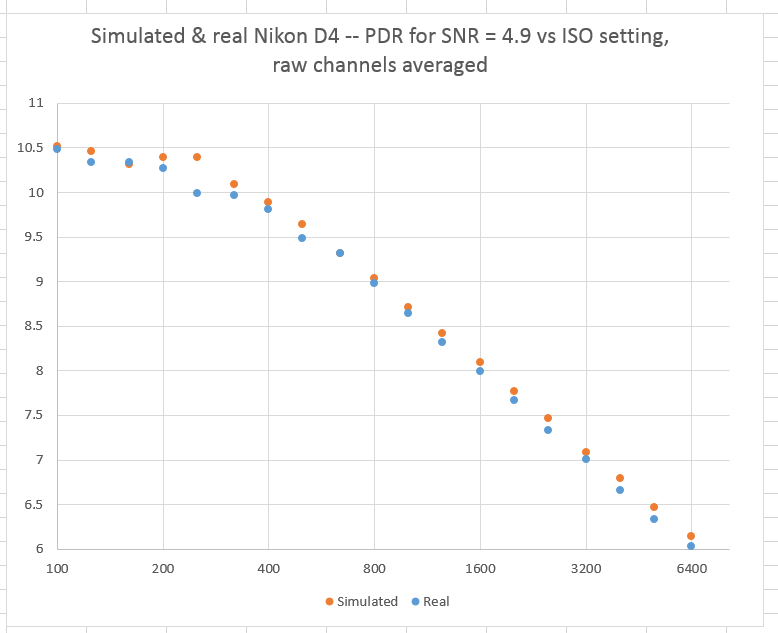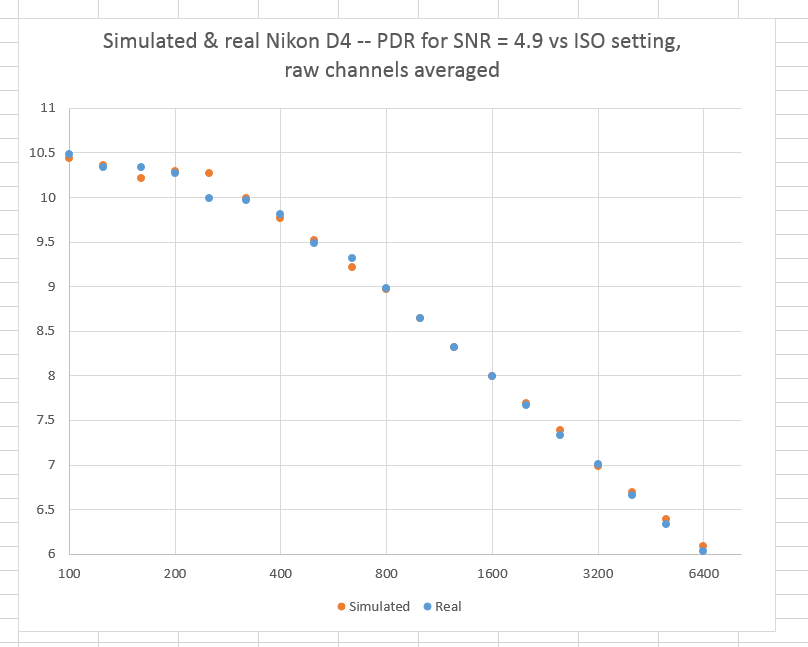In yesterday’s post, I speculated that the Claff Photographic Dynamic Range Curves created by by direct search might be smoother if the searched data set was from a simulated camera rather than a real one.
I programmed up a Nikon D4 simulator that used the modeled read noise values from the data set. I picked the D4 because it subtracts out the black point in-camera, with the potential to chop off some of the signal at low mean values, and I wanted to see if that was a problem for computing Claff PDR. I told the simulator to not truncate the histogram.
I ran the simulator to produce a spreadsheet of means and standard deviations, then analysed that with my PDR program. The results looked just about as lumpy as the real camera results, Then I changed the exposure increment from 1/3 stop to 1/10 stop, and things smoothed out:
The data point at ISO 250 is more believable in the simulated result, but it makes the point at ISO 160 look suspiciously low. The systematic discrepancies at high ISOs are because I just simulated one raw channel, whereas the data points for the real camera are an average of all four raw channels. I just used one FWC for all the ISOs.
If I take the average read noise at each ISO as my target we get a little closer:
The discrepancies at ISO 160 and 250 remain.
My conclusions are:
Most of the lumpiness in the real camera curves is caused by the coarse exposure sampling, which makes the average difference between the searched-for SNR and the found SNR larger.
It is impractical to make more exposures, but it’s desirable to sample the mean values more densely. Therefore, I will experiment with using a gradient for a target, so that I can sample several different mean values in a single exposure.
In the case of the D4, the histogram truncation performed by the camera did not affect the Claff PDR results. In the case of other cameras, it might. I should probably run simulations to check whenever I test a camera that does histogram truncation. By the way, none of the three Sonys tested yesterday do that.


Jim,
What advantage/difference does the histogram truncation give the D4 in a real world image? Would the same scene (real or simulated) at the same iso (given that is a variable between cameras) be visibly different between a D4 and an A7S ?
Thanks for the questions, Chris.
>What advantage/difference does the histogram truncation give the D4 in a real world image?
None, as far as I’m concerned. I think that function should be performed in post, where the photographer has some control over it.
>Would the same scene (real or simulated) at the same iso (given that is a variable between cameras) be visibly different between a D4 and an A7S ?
I’m assuming you’re talking about high ISO settings. The a7S has better high-ISO performance than the D4, starting st ISO 2000. The shadows in the a8S image will be less noisy than in the D4 image at the same ISO. That assumes the black point is the same for the two images. Said another way, it assumes that the photographer sets the 17S black point in the raw developer the same place the D4 firmware sets in in the camera.
Jim
Hi Jim,
Very good work. Do you have the a7r?
I do think the a7r has the same sensor as D810?!
It would be great to see the difference between a7r to D810!
Best and happy new year
Jean Pierre
Jean Pierre,
I do have an a7R. It has a different sensor than the D810. I’m sure of that because the D810 has EFCS, and the a7R does not. If the a7R had EFCS, all the shutter shock issues would disappear. I will consider running a series of photon transfer tests on the a7R, but, as I suspect it is soon to be replaced in the alpha 7 line up, I’m not sure it will be of interest to lots of people.
Jim
OK, Jim
Let’s wait for the up-line of the a7r. It will come 2015, shure.